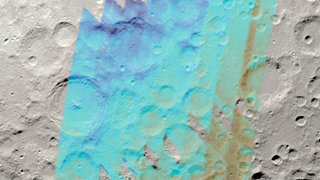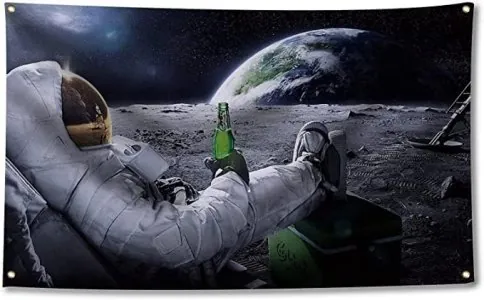Il y a aussi des cratères sur Mercure pourtant proche du Soleil .
 A visualization of SOFIA data measuring a signal or "light signature" of water overlaid on a visualization of the Moon as it appeared at the time of the observations in Feb. 2022. Darker blue indicates a higher concentration of water. (Image credit: NASA's Goddard Space Flight Center Scientific Visualization Studio/Ernie Wright)
A visualization of SOFIA data measuring a signal or "light signature" of water overlaid on a visualization of the Moon as it appeared at the time of the observations in Feb. 2022. Darker blue indicates a higher concentration of water. (Image credit: NASA's Goddard Space Flight Center Scientific Visualization Studio/Ernie Wright)
The moon has a water cycle that scientists don't yet fully understand. (Image credit: Jeff Overs/BBC News & Current Affairs via Getty Images)
The moon is strewn with minuscule beads of glass that have formed over billions of years as soil ejected during asteroid impacts cools and falls back to the lunar surface. An analysis of lunar samples delivered to Earth by China's Chang'e-5 probe has now revealed that those beads contain a substantial amount of water.
The presence of water on the moon is no news. NASA's lunar orbiters found evidence of the life-giving liquid inside the moon's permanently shadowed polar craters already in the 1990s. In the 2000s, a reanalysis of samples from the manned Apollo missions of the late 1960s and 1970s detected hydrogen in the lunar soil. And the recently retired infrared telescope SOFIA confirmed in 2020 that water is present on the moon, even outside the dark craters. The origin and behavior of this lunar water is, however, still somewhat unclear.
However, the glass beads found in the 61.1 ounces (1,731 grams) of lunar regolith brought to our planet by Chang’e-5 in December 2020 might provide the missing piece in this puzzle.

The moon has a water cycle that scientists don't yet fully understand. (Image credit: Jeff Overs/BBC News & Current Affairs via Getty Images)
The moon is strewn with minuscule beads of glass that have formed over billions of years as soil ejected during asteroid impacts cools and falls back to the lunar surface. An analysis of lunar samples delivered to Earth by China's Chang'e-5 probe has now revealed that those beads contain a substantial amount of water.
The presence of water on the moon is no news. NASA's lunar orbiters found evidence of the life-giving liquid inside the moon's permanently shadowed polar craters already in the 1990s. In the 2000s, a reanalysis of samples from the manned Apollo missions of the late 1960s and 1970s detected hydrogen in the lunar soil. And the recently retired infrared telescope SOFIA confirmed in 2020 that water is present on the moon, even outside the dark craters. The origin and behavior of this lunar water is, however, still somewhat unclear.
However, the glass beads found in the 61.1 ounces (1,731 grams) of lunar regolith brought to our planet by Chang’e-5 in December 2020 might provide the missing piece in this puzzle.


